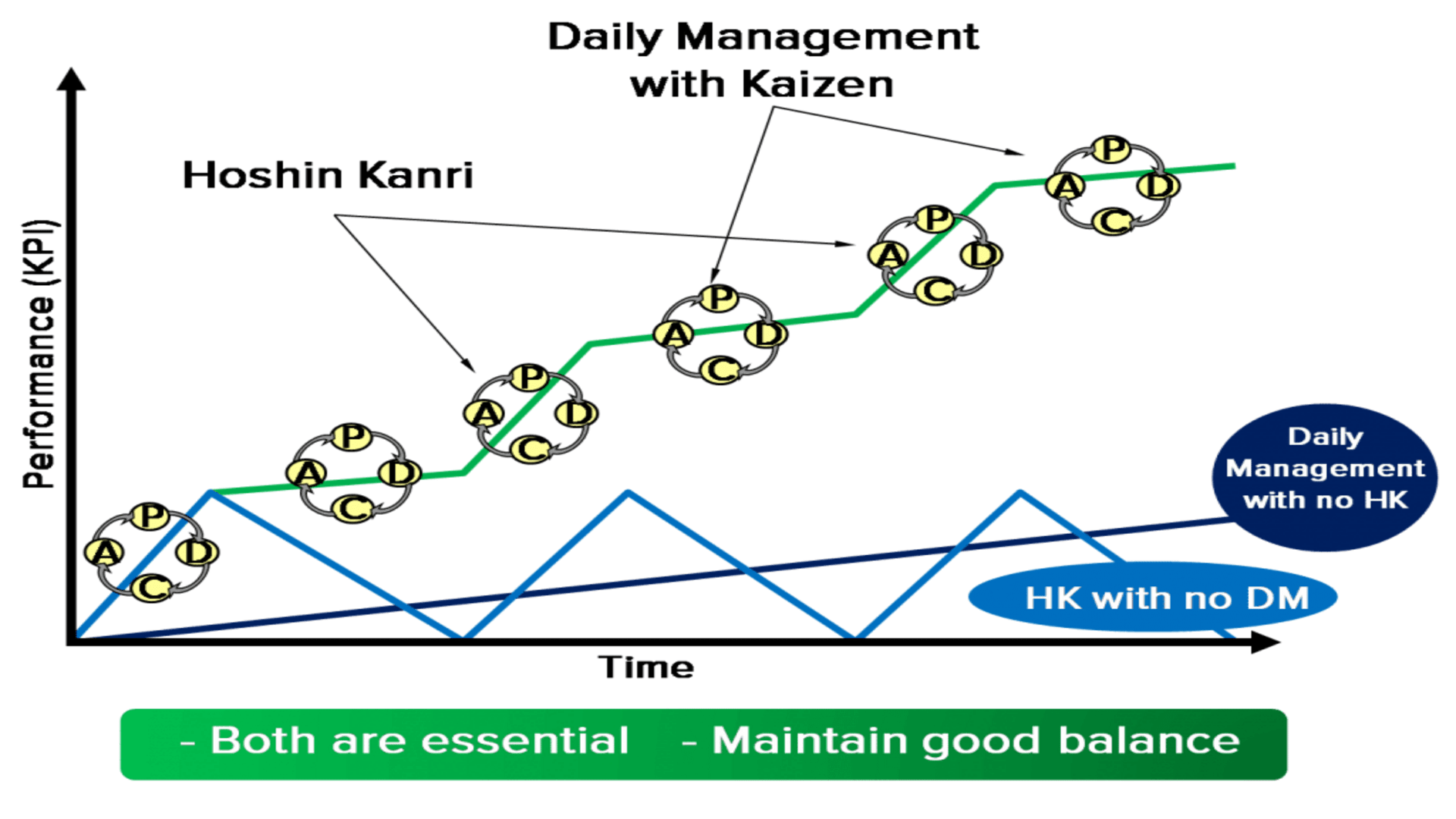In the ever-shifting terrain of the business world, enterprises strive not merely to keep pace but to outshine through constant refinement and strategic acumen. Two methodologies gaining increasing prominence in this pursuit are Hoshin Kanri and Kaizen. This conversation delves into the pivotal role of Hoshin Kanri in the sphere of Human Resources, unraveling its practical implementations and the seamless harmony it shares with the foundational principles of Kaizen.
Understanding Hoshin Kanri:
Hoshin Kanri, often referred to as Policy Deployment or Hoshin Planning, is a Japanese strategic planning methodology that originated in the 1960s. The term ‘Hoshin Kanri’ translates to ‘compass management,’ indicating its role in aligning organizational objectives with daily operations.
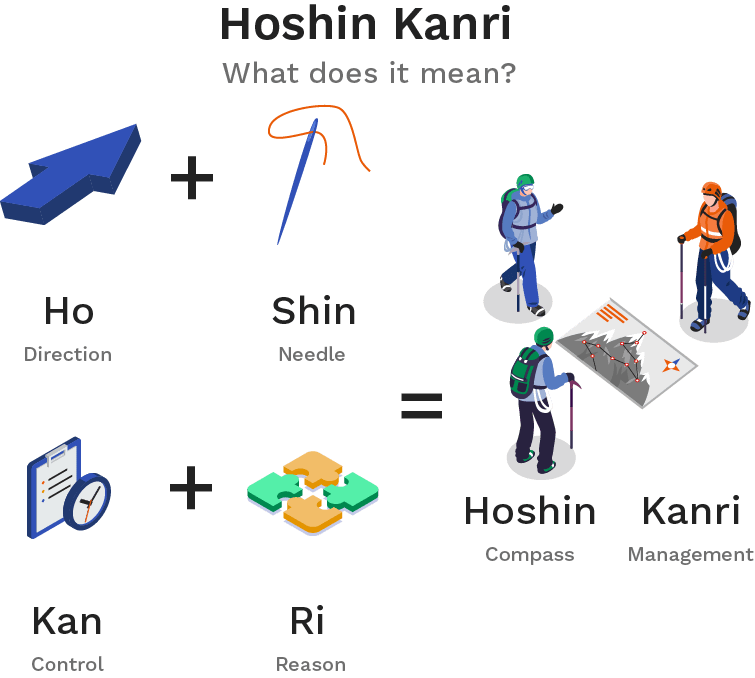
Relevance in HR:
- Strategic Workforce Planning:
- In HR, Hoshin Kanri plays a pivotal role in aligning human resources with the organization’s strategic goals. For instance, if a company aims to expand its market share globally, HR can use Hoshin Kanri to ensure that the workforce possesses the necessary skills and cultural awareness.
- Performance Management:
- Hoshin Kanri emphasizes the importance of clear performance metrics aligned with organizational objectives. HR professionals can use this methodology to set and monitor key performance indicators (KPIs) for individuals and teams, fostering a culture of continuous improvement.
- Talent Development and Deployment:
- HR can utilize Hoshin Kanri to identify critical talent needs, ensuring the organization has the right people in the right roles. By aligning talent development programs with strategic objectives, Hoshin Kanri ensures a workforce that is capable of driving the company’s long-term success.
Real-World Example:
Consider a multinational corporation planning to enhance innovation. Through Hoshin Kanri, HR can identify and develop talent with creative thinking skills. They can implement training programs, mentorship initiatives, and performance assessments that specifically target innovation-related competencies.
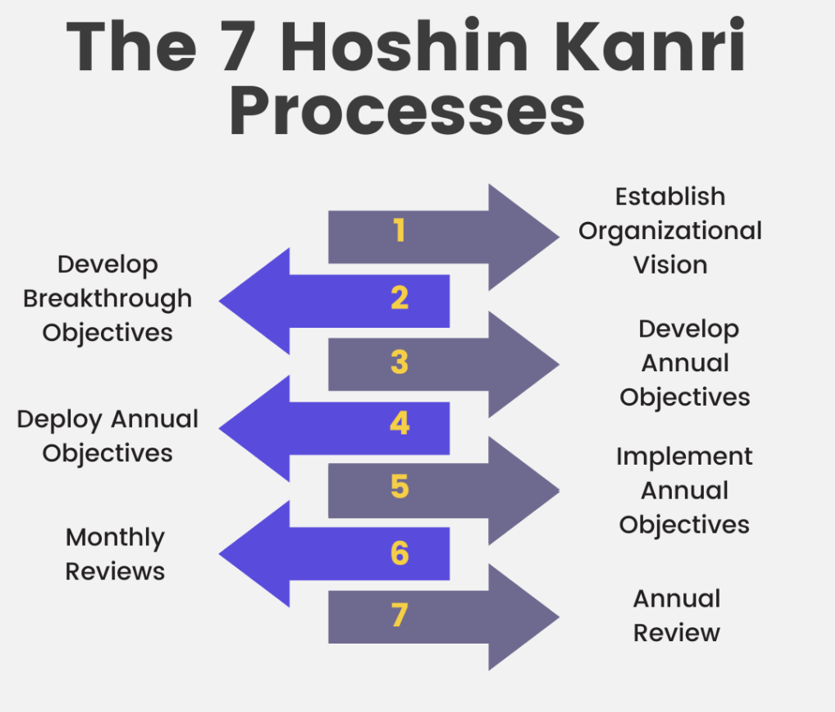
Steps Involved in Hoshin Kanri:
- Establishing Organizational Objectives:
- The process begins with senior leadership defining the long-term objectives of the organization. These objectives should be clear, measurable, and aligned with the company’s mission and vision.
- Cascade Objectives:
- The identified objectives are then cascaded down through the organization’s hierarchy. Each level of management aligns its goals with the higher-level objectives, ensuring a cohesive approach throughout the organization.
- Developing Annual Plans:
- Annual plans are created to support the achievement of the established objectives. HR, in collaboration with other departments, designs workforce strategies, talent development initiatives, and performance management systems aligned with these plans.
- Deployment:
- The plans are deployed across the organization, ensuring that every department and employee understands their role in achieving the established objectives. This step involves effective communication and engagement to garner commitment at all levels.
- Monitoring and Feedback:
- Regular monitoring and feedback mechanisms are put in place to assess the progress towards objectives. HR plays a crucial role in collecting and analyzing data related to workforce performance and development.
- Adjustment and Adaptation:
- Hoshin Kanri acknowledges that the business environment is dynamic. If there are changes in the market, internal dynamics, or organizational priorities, the Hoshin Kanri plan is adjusted accordingly. This adaptability ensures ongoing relevance and effectiveness.
Understanding Kaizen:
Kaizen, a Japanese term meaning “change for better” or “continuous improvement,” is a philosophy that revolves around making small, incremental changes in processes to enhance efficiency and productivity. Originating in post-World War II Japan, Kaizen gained prominence through its application in manufacturing by companies like Toyota. Over time, its principles have transcended manufacturing, finding applications in various industries, including the HR field.
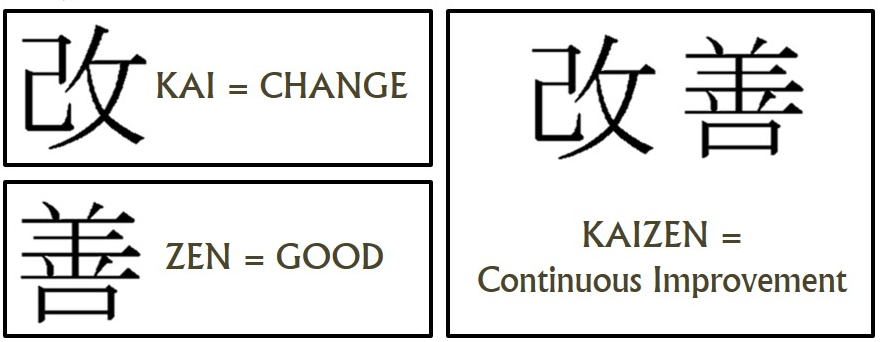
Relevance in HR:
- Employee Engagement:
- Kaizen emphasizes the active involvement of employees in the improvement process. In HR, this translates to fostering a culture where employees at all levels are encouraged to contribute ideas for enhancing their work environment, processes, and overall job satisfaction.
- Continuous Learning and Development:
- HR can leverage Kaizen to promote a mindset of continuous learning and development. By encouraging employees to seek small, regular improvements in their skills and knowledge, organizations can stay ahead in a rapidly changing business landscape.
- Workflow Optimization:
- Kaizen principles are applicable to HR processes such as recruitment, onboarding, and performance management. Regularly reviewing and refining these processes can lead to smoother workflows, reduced inefficiencies, and a better overall experience for both employees and HR professionals.
Real-World Example:
Consider an HR department implementing Kaizen to improve the onboarding process for new hires. By involving employees from different teams in brainstorming sessions, they identify small adjustments, such as streamlining paperwork, clarifying communication channels, and providing additional resources for quicker integration. These incremental changes, when implemented collectively, significantly enhance the onboarding experience and contribute to long-term employee satisfaction.
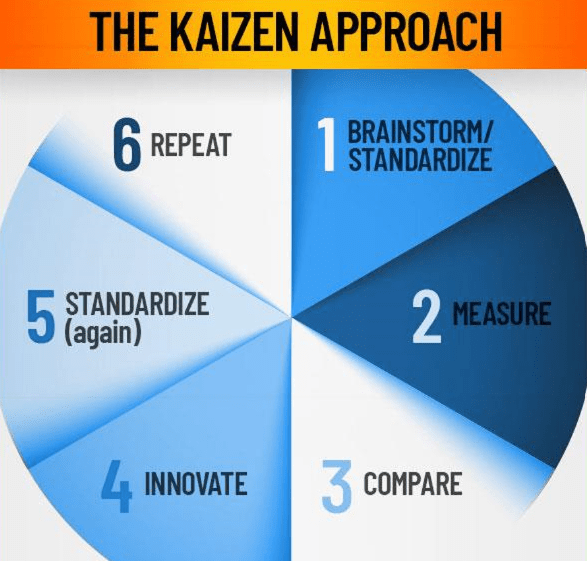
Steps Involved in Kaizen:
- Identify Areas for Improvement:
- Kaizen starts by recognizing that improvement is always possible. HR teams, together with employees, identify specific areas that can benefit from small changes. This could range from communication processes to training methods.
- Empower Employees:
- Kaizen is rooted in the idea that those closest to the work understand it best. HR empowers employees at all levels to actively participate in suggesting and implementing improvements, fostering a sense of ownership and accountability.
- Collect and Evaluate Ideas:
- Ideas for improvement are collected through various channels, including suggestion boxes, team meetings, or dedicated improvement sessions. HR plays a vital role in evaluating these ideas, considering their feasibility and alignment with organizational objectives.
- Pilot Testing:
- Before full-scale implementation, proposed changes are tested on a small scale. This allows HR and employees to assess the impact and identify any unforeseen challenges, ensuring that the improvements are effective before broader implementation.
- Implement Changes:
- Once the pilot testing is successful, the changes are implemented across the organization. HR is instrumental in communicating these changes effectively, ensuring that everyone understands the rationale and benefits behind the improvements.
- Training and Skill Development:
- Kaizen recognizes the importance of ongoing training and skill development. HR facilitates the necessary training sessions to equip employees with the skills required to adapt to new processes and technologies resulting from the improvement initiatives.
- Measure and Monitor:
- Metrics are established to measure the impact of the implemented changes. HR collaborates with other departments to track key performance indicators (KPIs) related to the improvement areas, providing valuable data for future decision-making.
- Feedback and Recognition:
- Kaizen fosters a culture of feedback and recognition. HR actively seeks feedback from employees on the implemented changes and recognizes contributions to continuous improvement. This positive reinforcement encourages a sustained commitment to the Kaizen philosophy.
- Iterate and Repeat:
- Kaizen is a cyclical process. After the initial implementation, HR teams and employees continuously monitor, gather feedback, and iterate on the improvements. This iterative cycle ensures that the organization remains adaptable and responsive to evolving challenges.
Comparing Hoshin Kanri and Kaizen:
While both Hoshin Kanri and Kaizen share the goal of improvement, they differ in scope and application.
- Scope:
- Hoshin Kanri: Focuses on aligning organizational objectives with strategic initiatives. It involves a top-down approach, ensuring that everyone in the organization understands and contributes to the overall strategy.
- Kaizen: Centers on continuous improvement at all levels of the organization, encouraging incremental changes by employees in their daily work.
- Application:
- Hoshin Kanri: Typically implemented during annual planning cycles, setting long-term objectives and key strategies. It provides a structured framework for achieving these goals.
- Kaizen: Ongoing and day-to-day improvement activities. Kaizen involves small, frequent changes that collectively lead to significant improvements over time.
Complementary Nature of Hoshin Kanri and Kaizen:
While Hoshin Kanri and Kaizen differ in their approach, they are not mutually exclusive. In fact, they can be synergistically employed to achieve holistic organizational improvement.
- Scenario 1: Strategic Alignment with Continuous Improvement:
- Hoshin Kanri: The HR department uses Hoshin Kanri to align talent acquisition, development, and retention strategies with the organization’s long-term objectives.
- Kaizen: Once the strategic plan is in place, Kaizen principles can be applied to enhance daily HR operations continually. This may include refining recruitment processes, optimizing training modules, and streamlining performance appraisal systems.
- Scenario 2: Agile Response to Changing Market Dynamics:
- Hoshin Kanri: The organization faces unexpected market shifts. Hoshin Kanri allows HR to swiftly realign workforce strategies, ensuring that the right skills are in place to adapt to the new business environment.
- Kaizen: Employees are encouraged to contribute ideas for adapting to the changes. Kaizen workshops and initiatives empower teams to identify and implement small but impactful changes in response to evolving market demands.
- Scenario 3: Employee Engagement and Satisfaction:
- Hoshin Kanri: HR uses Hoshin Kanri to set strategic goals related to employee engagement and satisfaction. This may involve initiatives like improving work-life balance, career development opportunities, or enhancing workplace culture.
- Kaizen: Employee feedback is regularly collected and used to make incremental improvements in HR policies, creating a workplace where continuous enhancement is embedded in the organizational culture.
- Scenario 4: Cross-Functional Collaboration:
- Hoshin Kanri: HR collaborates with other departments to ensure that workforce planning aligns with the broader organizational strategy. This includes working closely with finance, operations, and marketing to understand their needs and align HR initiatives accordingly.
- Kaizen: Cross-functional teams can be formed to address specific challenges or opportunities. Kaizen events bring together employees from different departments to brainstorm and implement improvements, fostering collaboration and a shared sense of purpose.
Integration of PDCA in Hoshin Kanri and Kaizen:
Both Hoshin Kanri and Kaizen methodologies share a common thread in their commitment to continuous improvement, and a key aspect that binds them together is the application of the Plan-Do-Check-Act (PDCA) cycle. The PDCA cycle, also known as the Deming Cycle or Shewhart Cycle, is a four-step iterative management method used for the continuous improvement of processes and products. Let’s explore how Hoshin Kanri and Kaizen incorporate the PDCA cycle in their application:
Hoshin Kanri and PDCA:
1. Plan:
- In the planning phase of Hoshin Kanri, senior leaders collaborate to establish the long-term objectives and strategies for the organization. This planning involves a thorough analysis of the current state, market trends, and competitive landscape. The identified objectives set the direction for the entire organization.
2. Do:
- The execution or “Do” phase in Hoshin Kanri involves cascading the strategic plans throughout the organization. Each department and team aligns their goals with the overarching strategic objectives. Implementation of initiatives and allocation of resources occur during this phase, ensuring that the planned strategies are put into action.
3. Check:
- Regular monitoring and assessment are integral to Hoshin Kanri. The “Check” phase involves evaluating the progress of the implemented strategies against the established objectives. Key performance indicators (KPIs) are monitored to ensure alignment with the strategic direction. If deviations or issues are identified, adjustments can be made.
4. Act:
- The “Act” phase in Hoshin Kanri is about adapting to changes and improving the strategies based on feedback and monitoring results. If the data from the Check phase indicates a need for modification or if there are shifts in the external environment, adjustments are made to the strategic plans. This ensures that the organization remains agile and responsive to evolving circumstances.
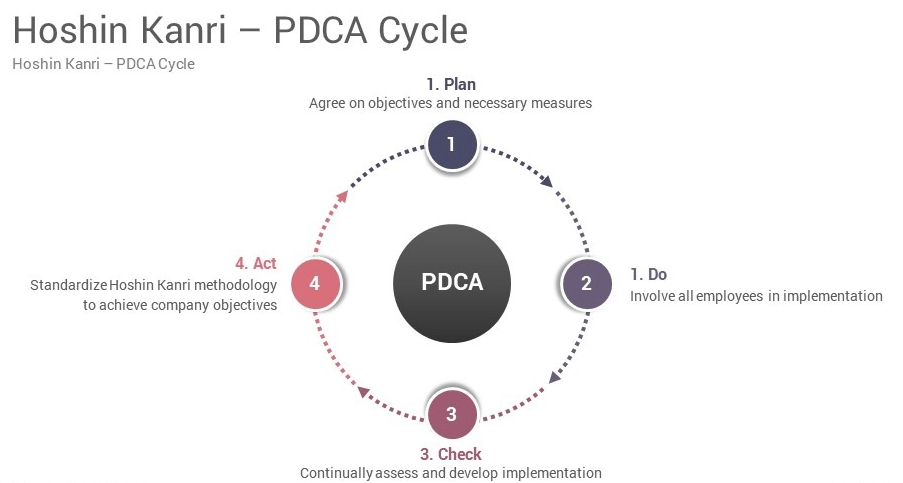
Kaizen and PDCA:
1. Plan:
- In Kaizen, the planning phase involves identifying areas for improvement. This could be at the level of processes, workflows, or individual tasks. Employees and teams collaborate to plan small, incremental changes aimed at enhancing efficiency, quality, or safety.
2. Do:
- The “Do” phase in Kaizen is the implementation of the planned changes on a small scale. This could involve a pilot project or a trial run to test the proposed improvements. During this phase, employees actively participate in making the changes a reality.
3. Check:
- Kaizen emphasizes the importance of feedback and evaluation. In the “Check” phase, the impact of the implemented changes is assessed. Data is collected, and feedback from employees and relevant stakeholders is considered to understand whether the changes have achieved the desired outcomes.
4. Act:
- The essence of Kaizen lies in its continuous cycle of improvement. The “Act” phase involves standardizing successful changes into regular processes and workflows. It also entails learning from the outcomes of the changes, whether positive or negative, and using that knowledge to plan the next cycle of improvements.
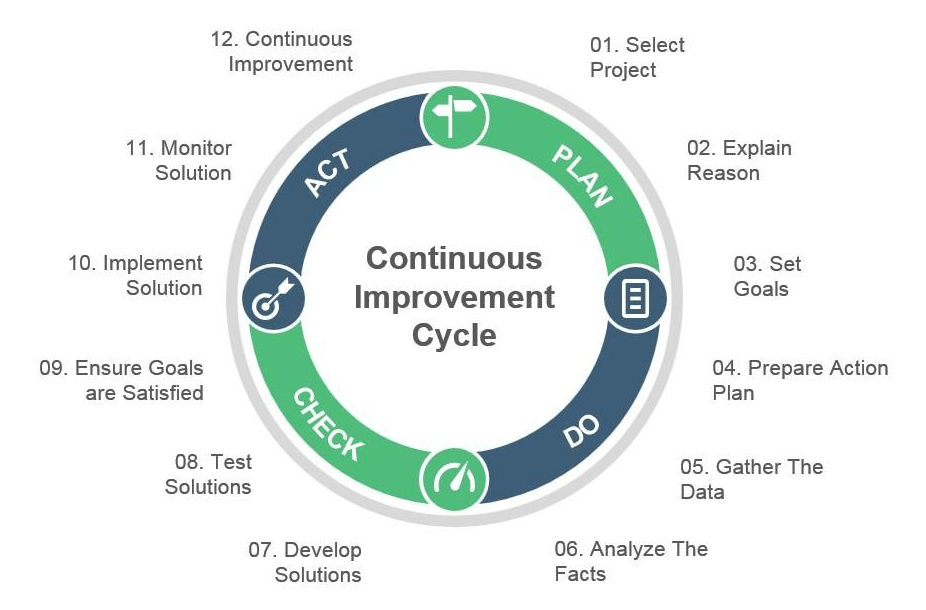
Integration and Synergy:
The PDCA cycle is seamlessly integrated into both Hoshin Kanri and Kaizen, forming the backbone of their continuous improvement approaches. In Hoshin Kanri, the PDCA cycle operates at a strategic level, guiding the organization’s long-term planning and ensuring adaptability to changing circumstances. Kaizen, on the other hand, brings the PDCA cycle to the frontline, empowering employees to contribute to ongoing improvement in their daily work.
Synergy in Application:
- Hoshin Kanri and Kaizen complement each other by combining strategic planning with continuous improvement at all levels. Hoshin Kanri sets the direction and overarching goals through PDCA at a macro level, while Kaizen applies PDCA at a micro level, allowing for nimble and agile adjustments based on real-time feedback.
Scenario: A Comprehensive PDCA Approach:
- Consider an organization aiming to improve its customer service. Hoshin Kanri identifies this as a strategic goal during the planning phase. The strategic plan is cascaded down through the organization, with each department aligning their objectives to improve customer service.
- Kaizen comes into play at the operational level. Employees on the frontline, armed with the understanding of the strategic goal, identify specific areas for improvement in customer service processes. They plan small changes (Plan), implement these changes in their daily interactions with customers (Do), collect feedback and assess the impact (Check), and finally standardize successful improvements into regular practices (Act).
- This holistic approach ensures that the organization is not only strategically aligned but is also continually refining and enhancing its processes based on real-world feedback and outcomes.
Conclusion:
In the dynamic landscape of the HR field, Hoshin Kanri and Kaizen emerge as powerful tools for organizations aspiring to achieve excellence. Hoshin Kanri provides the strategic direction and alignment necessary for success, while Kaizen ensures that the journey towards improvement is continuous and adaptable.
By understanding the nuances of each methodology and leveraging their complementary nature, HR professionals can navigate the complexities of organizational management, fostering a culture of innovation, agility, and sustained growth.
Incorporating Hoshin Kanri and Kaizen into the HR framework requires commitment, collaboration, and a willingness to embrace change. Organizations that successfully integrate these methodologies are better equipped to navigate challenges, capitalize on opportunities, and cultivate a workforce that propels them towards enduring success. As we delve deeper into the practical application of Hoshin Kanri and Kaizen, organizations can unlock the full potential of their human capital, creating a workplace where strategic goals and continuous improvement go hand in hand.







